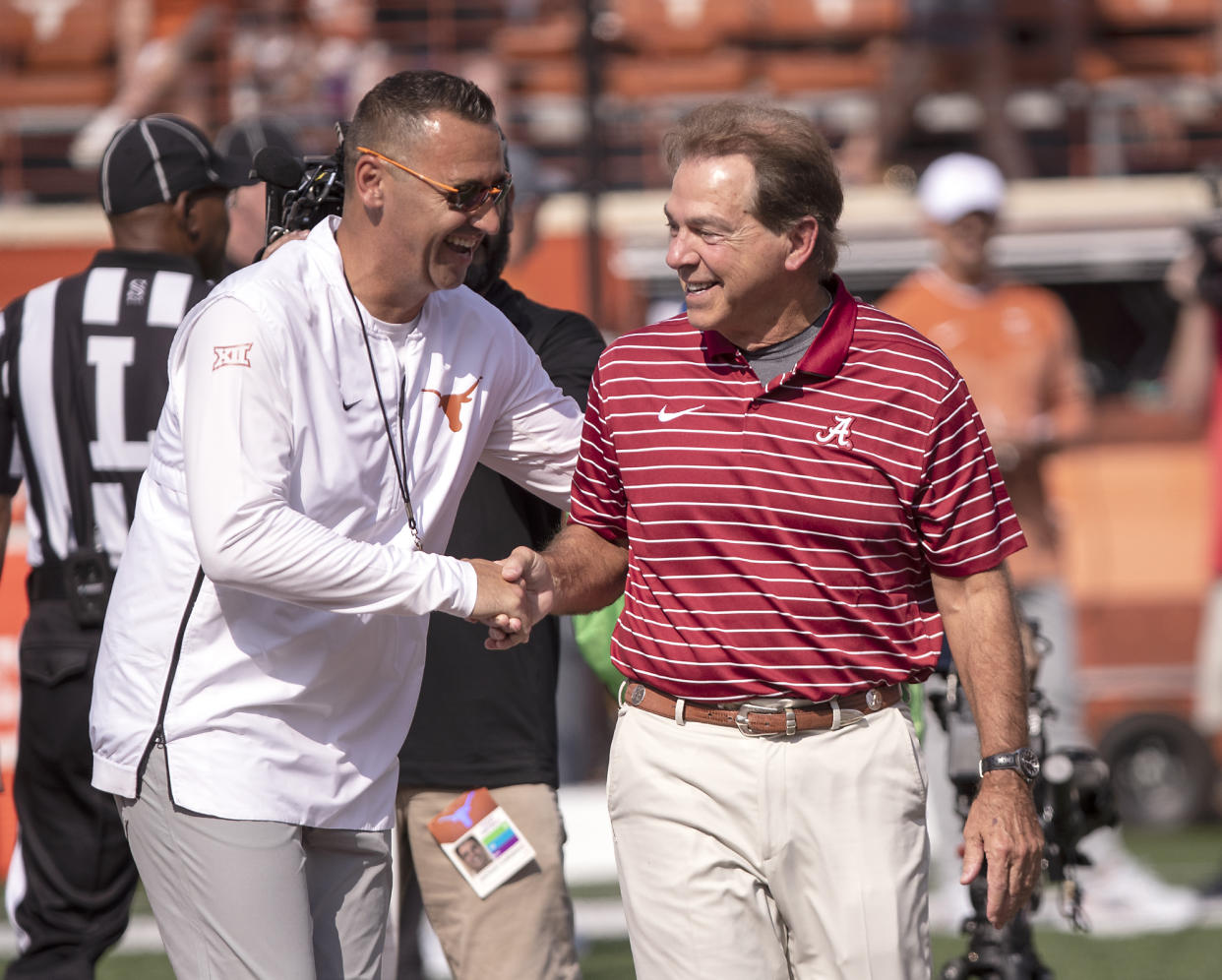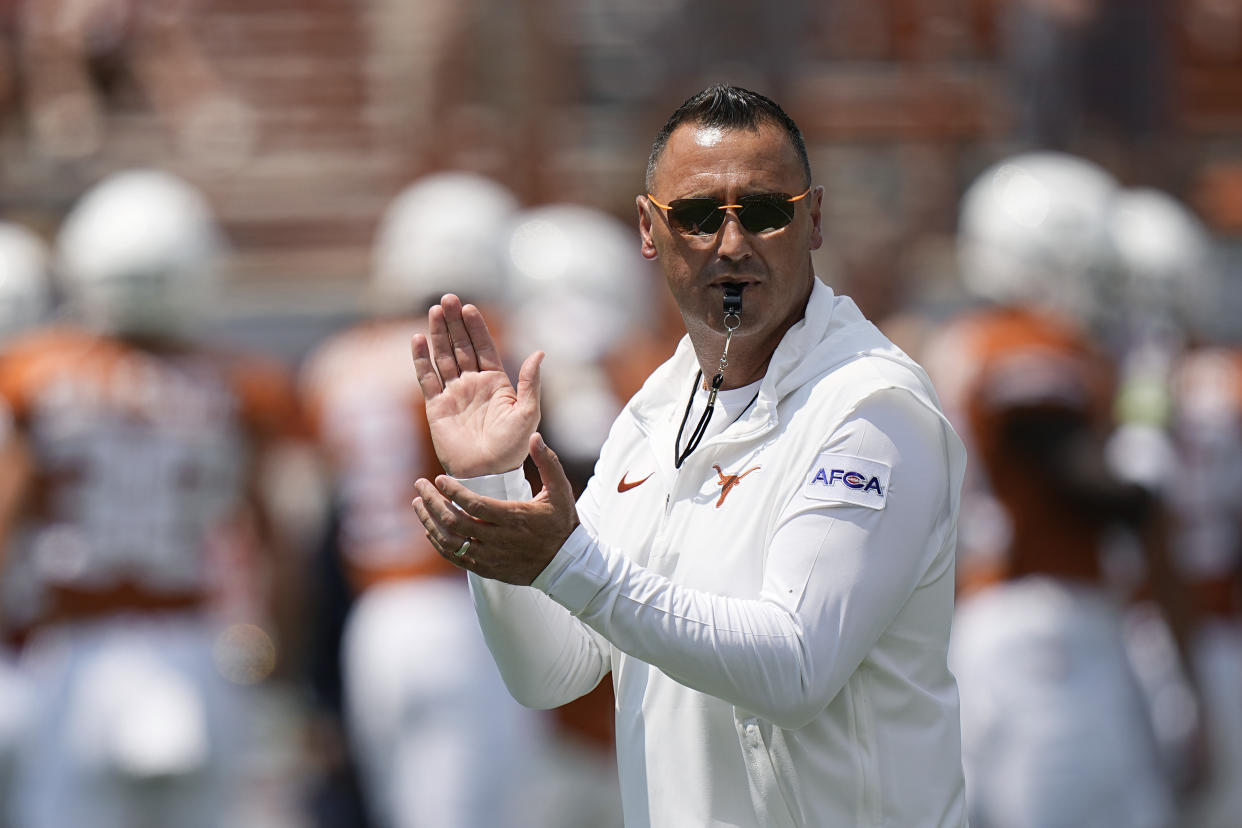'He was a ticking time bomb' — Steve Sarkisian takes Texas back to the place that may have saved his life
AUSTIN, Texas — Leaning back in his office chair, Steve Sarkisian taps on his chest.
Thump. Thump.
His University of Texas T-shirt hides a 7-inch vertical scar stretching from the top of his rib cage to his stomach. Beneath it, his sternum is held together by wiring after doctors sawed through it three years ago. Beneath that, his beating heart pumps blood throughout his body with help from an implanted bioprosthetic valve from a farm animal.
“I’ve got pig s*** in here,” he says with a laugh.
He means a pig valve, and for those who have undergone surgery to repair a congenital anomaly for a bicuspid valve, it’s quite common. That’s a lot of complicated medical terms. In more simple phrasing, Sarkisian was potentially days and certainly weeks away from suffering a life-ending heart aneurysm.
“The comment from the doctor was that he would have dropped dead one day out on the field,” said Sarkisian’s friend and Texas assistant Jeff Banks.
Much has been talked and written about Alabama coach Nick Saban saving Sarkisian’s coaching career, hiring him as an analyst in 2016 after alcoholism led to a firing at USC and then rehiring him in 2019 to run the Tide’s offense.
Loreal Sarkisian says the real story is something far more significant: Saban saved her husband’s life.
In July 2020, during an intensive physical exam that Alabama administers annually on its football staff, physicians learned of the heart issue and sent Sarkisian into emergency surgery, where doctors put him into deep hypothermic circulatory arrest. They slowed his heart to a crawl, dropped his body temperature and then cut him open.
In an interview with Yahoo Sports last month, he spoke in depth for the first time about the situation.
“I was cleared to coach — miraculously at Alabama! — the night before camp,” Sarkisian says, now able to laugh about the ordeal. “At Alabama, we always joke, ‘Just send them to Birmingham and they’ll get you fixed!’ Well, they did.”
More than three years later, Sarkisian, mended heart and all, returns to Tuscaloosa to lead his 11th-ranked Texas Longhorns into a game against his former boss and program, the third-ranked Alabama Crimson Tide — a prime-time duel between the SEC’s longtime powerhouse against the SEC’s soon-to-be Goliath (at least from a revenue perspective).
There are plenty of storylines.
After all, how could anyone forget their game last year in Austin, when the Longhorns missed a game-winning sack and Alabama then made a game-winning field goal?
The trajectory of the two programs — so similar in resources, recruiting ground and revenue — is fascinating. Is Alabama at the tail end of its dynasty? Can Texas win a game to usher in its own dominance of its new conference?
In Year 3, Sarkisian has loaded up the Longhorns with talent (consecutive top-five signing classes and six five-star signees) and has a returning quarterback to boot. In Year 17, Saban is coming off consecutive seasons with at least two losses for the first time in a decade and has a quarterback situation that is, at best, an uncertainty.

Maybe the most serious storyline lies within the chest of the visiting coach.
“He was a ticking time bomb,” Loreal said.
About 15 years ago, two years into Saban’s tenure, Alabama athletic trainers and team doctors decided to perform a physical on Saban. This wasn’t a routine physical but a three-hour ordeal with a cacophony of diagnostic tests, ultrasounds, blood testing and doctor visits, including gastrointestinal specialists and cardiologists.
Saban recommended that his entire staff get the same treatment every year.
“These guys are in high-stressed positions, so we want to make sure they are good,” said Jeff Allen, the school’s associate athletic director for sports medicine. “We’ve picked up on a lot of things over the years with our coaches, but this one was the most serious. It wasn’t even close.”
The treadmill stress test followed by a cardiac MRI revealed Steve Sarkisian’s condition: a congenital cardiovascular anomaly, which is a broad term used for a variety of heart issues. Sarkisian’s situation involved the bicuspid aortic valve.
Most people are born with a three-flap valve, or a tricuspid valve. Sarkisian was born with a two-flap valve. About 1 percent of the population is born with a bicuspid valve. Not everyone needs surgery or even realizes they have the condition.
But the aortic valve is significant to a person’s blood flow. The valve, sitting between the heart’s two chambers, acts as a “doorway” for blood exiting the heart, says Matt Martinez, the director of Atlantic Health System Sports Cardiology at Morristown Medical Center in New Jersey.
If the aortic valve is too narrow, blood can’t easily pass through. If it is too constricted, blood leaks back into the heart muscle, causing a swelling of the aorta, the main artery delivering blood to the body.
Sarkisian’s doorway was shut, blood was leaking into the heart and his aorta had swelled to the point of a near ruptured aneurysm.
“We don’t get nervous until the aorta gets to 5 centimeters,” Martinez said, “and 6 is a very high risk of tearing.”
Sarkisian’s aorta was at 6.5 centimeters.
“If they didn’t find it, he would have had a 5 percent chance to live,” Loreal said.
Allen remembers receiving the first call from the doctor in Birmingham who’d administered the physical.
“This is serious,” he told Allen. “It cannot wait.”
“We’re a month away from the season!” Allen told him.
“Look,” the doctor said, “I know you guys live in a different world, but some things are more important than football.”
A few days into his only vacation of the year, Banks found himself on an impromptu Zoom call with Sarkisian, then-offensive coordinator, and the other offensive coaches. He’s got a problem with his heart, he told them, needed surgery and would be out for at least a few weeks.
Four days after the diagnosis, Sarkisian underwent an intense procedure in Birmingham. Surgeons made their incision, sawed the sternum with a surgical tool and replaced his valve with one from a pig. They used a technique common with intensive heart surgeries, nearly stopping his heart and cooling his body to under 80 degrees.
“I don’t want to say he was dead, but he was almost dead,” Loreal said.
After the procedure, doctors emerged with news that, while troubling, was routine for such a surgery.
“They come out and say, ‘We have to let his body warm up. Like, come back to life,’” Loreal said. “That was scary. It’s like, ‘What if he doesn’t come back?’”
Recovery was trying, especially given COVID protocols. This all happened about four months into the pandemic and a week after Steve and Loreal got hitched in a small wedding ceremony. Steve spent a week in the hospital and another week at home relearning basic functionality. Thinking. Talking. Reading. Walking.
Loreal describes it as watching her husband’s brain return to life. She often wondered if he’d ever come back fully to normal activity, “not to mention that he was the play-caller for Alabama a month before camp,” she said.
He’d have heart and lung exercises, like taking deep breaths and blowing into something. She helped him walk. They’d set goals to reach: to the end of the bed, down the hallway, around the living room.
Two weeks after surgery, he began Zooming in with coaches and players during NFL-like walkthrough practices that the NCAA approved during the pandemic.
Finally, he was able to walk on his own but with a cane. Soon, he could walk without any assistance. One day, without telling Loreal, he sneaked outside to walk two miles on a July day in Alabama. He returned soaked in sweat, heaving of breath and near collapse. “I lost it!” Loreal remembered.

About three weeks after surgery, he returned to the office but couldn’t drive. Loreal chauffeured her husband every day at 5 a.m.
He arrived into the office like a kid with a new haircut.
“Who wants to see my scar!” he announced to the staff before slipping off his shirt and showing it off.
“It was crazy,” Banks said. “It’s a huge scar.”
Post-surgery, Sarkisian looks at life a bit differently.
He’s fought a few self-made problems in the past, many of them very public. A father of three, he went through a difficult divorce while at USC and then was fired over alcohol-related issues. He’s been sober now for eight years.
He takes nothing for granted. On his expansive desk in the Texas football facility, he keeps a half-dozen motivational books, jots down inspirational quotes from them and has created what he calls a “Gratitude Tree.”
Within each leaf of the drawing of a tree, Sarkisian has scribbled the name of a person or group of people for which he is grateful: his parents, his wife, his children, Texas players, the university in general, his house and car, and shoes.
Shoes?
“I’m a big shoe guy,” he laughs.
He thinks about what happened eight years ago in Los Angeles every morning when he wakes up. And he’s reminded of what happened three years ago each time he touches that scar.
He’s gotten a couple of life do-overs. So he’s doing this one as well as possible and with positivity.
At 49, Sarkisian has more energy than ever, Banks said. He’s bouncing around the facility, he’s fiery, he’s fierce. To resurrect Texas, you’ve got to be.
“It’s easy when you wake up on third base and take over a job. We didn’t take over on third base here. We had to build it,” Sarkisian said.
He’s a different person than the man who took over the Longhorns three years ago. His team is different as well. During a 5-7 season in Year 1, his team wasn’t mentally tough enough to bounce back from excruciating losses (five of the seven by one score). In an eight-win Year 2, his team couldn’t close out opponents (the Longhorns held second-half leads in four of five losses).
So what’s in store for Year 3, with star quarterback Quinn Ewers and nine other offensive starters returning?
“Now it’s, ‘How do we put people away when we have leads?’” he said.
Maybe everyone will find out soon enough.
Sarkisian brings his Horns into a special place for him. In his second and final year as offensive coordinator, he helped lead the Tide to a 13-0 season in 2020, ending the year with a win over Ohio State in the national championship game.
It was a remarkable run through a wacky season. Ten SEC games. COVID protocols. And Sarkisian served as interim coach for the Tide’s 42-13 clobbering of Auburn after Saban tested positive for COVID.
And don’t forget one other thing, Allen said. “The offensive coordinator has major heart surgery a month before camp!”
